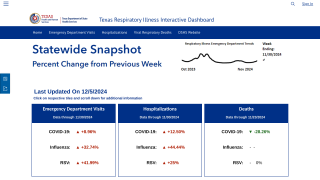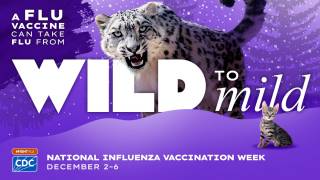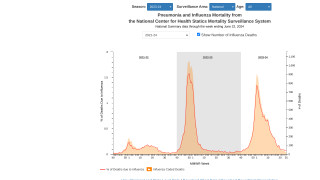CDC Flu News for March 22, 2019

According to the Centers for Disease Control and Prevention (CDC), the USA remains in the ‘peak’ flu season, with 26 states reporting high influenza-like-illness (ILI) activity.
This is actually good news when compared with last week (#10) when 30 states reported high ILI.
The CDC says during week #11 of the 2018-2019 flu season, influenza A(H1N1), influenza A(H3N2), and influenza B viruses continue to co-circulate.
In related news, the World Health Organization (WHO) advisors finalized their flu vaccine recommendations on the strains to include in the Northern Hemisphere 2019-20 flu vaccines.
The WHO recommended on March 21, 2019, the quadrivalent vaccines for use in the 2019-2020 northern hemisphere influenza season contain the following:
- an A/Brisbane/02/2018 (H1N1)pdm09-like virus
- an A/Kansas/14/2017 (H3N2)-like virus
- a B/Colorado/06/2017-like virus B/Victoria/2/87 lineage)
- a B/Phuket/3073/2013-like virus (B/Yamagata/16/88 lineage)
It is recommended that the influenza B virus component of trivalent vaccines be a B/Colorado/06/2017-like virus.
Their H3N2 recommendation reflects a change from the current Northern Hemisphere vaccine and is not a component of the Southern Hemisphere 2019 flu vaccines.
The WHO said the proportion of viruses falling into that H3N2 clade has increased substantially since November 2018 in several countries in Europe and especially the United States.
And, on March 15, 2019, the American Academy of Pediatrics (AAP) said it will no longer express an AAP preference between the flu shot or the nasal spray vaccine for children during the 2019-2020 flu season.
The CDC is now estimating the current flu season’s impact through March 16, 2019, as follows:
- 28,500,000 – 32,800,000 symptomatic illnesses
- 13,200,000 – 15,400,000 medical visits
- 375,000 – 454,000 hospitalizations
- 25,000 - 41,500 flu-related deaths
Note: The cumulative burden of influenza is an estimate based on data since October 2018.
Unfortunately, the CDC confirmed 76 influenza-associated pediatric deaths during the 2018-2019 season. Eight of these 76 pediatric deaths were reported during week #11 of the current flu season.
'Remember, if you haven't gotten the flu vaccine, it's not too late! Getting vaccinated is still the best way to protect you and your family from the flu,' said the Food and Drug Administration's Scott Gottlieb, M.D., on Twitter.
The CDC Week #11 report included these influenza indicators for the week ending March 16, 2019, which are as follows:
- The percentage of respiratory specimens testing positive for influenza viruses in clinical laboratories increased slightly. Nationally, during the most recent three weeks, influenza A(H3) viruses were reported more frequently than influenza A(H1N1) viruses and in HHS Regions 2, 4, 5, 6, 7, 8, 9 and 10.
- The majority of influenza viruses characterized antigenically are similar to the cell-grown reference viruses representing the 2018–2019 Northern Hemisphere influenza vaccine viruses. However, an increasing proportion of influenza A(H3N2) viruses are antigenically distinguishable from A/Singapore/INFIMH-16-0019/2016 (3C.2a1), a cell-propagated reference virus representing the A(H3N2) component of 2018-19 Northern Hemisphere influenza vaccines.
- The vast majority of influenza viruses tested (>99%) show susceptibility to oseltamivir and peramivir. All influenza viruses tested showed susceptibility to zanamivir.
- The proportion of outpatient visits for influenza-like illness (ILI) remained at 4.4%, which is above the national baseline of 2.2%. All 10 regions reported ILI at or above their region-specific baseline level.
- 26 states experienced high ILI activity; 12 states experienced moderate ILI activity; New York City, Puerto Rico and eight states experienced low ILI activity; four states experienced minimal ILI activity, and the U.S. Virgin Islands and the District of Columbia had insufficient data.
- The geographic spread of influenza in 44 states was reported as widespread; Puerto Rico and four states reported regional activity; the District of Columbia and two states reported local activity; the U.S. Virgin Islands reported sporadic activity, and Guam did not report.
- A cumulative rate of 47.1 laboratory-confirmed influenza-associated hospitalizations per 100,000 population was reported. The highest hospitalization rate is among adults 65 years and older (146.0 hospitalizations per 100,000 population).
- The proportion of deaths attributed to pneumonia and influenza (P&I) was below the system-specific epidemic threshold in the National Center for Health Statistics (NCHS) Mortality Surveillance System.
In the USA, antiviral medications and various flu vaccines remain available in most pharmacies.
The CDC Vaccine Price List provides private sector vaccine prices for general information. And, flu vaccine discounts can be found here.
Recent flu news:
- WHO Influenza News For March 20, 2019
- NasoVAX Extension Study Demonstrated 100% Seroprotection
- Pediatricians Now Endorse Both Flu Shots & Nasal Spray Vaccine
Vaccines, like any medicine, can have side effects. Vaccine patients are encouraged to report negative side effects of vaccines to the CDC.
Note: All CDC data are preliminary and may change as more reports are received. The CDC uses a model to estimate the numbers of influenza illnesses, medical visits, and hospitalizations in the United States.
Our Trust Standards: Medical Advisory Committee

























